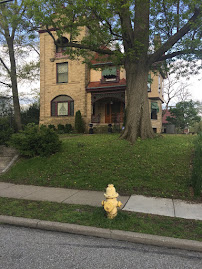Rick (Photo
source: 1954 “Maroon”, the Menominee H.S. Yearbook)
Dear George,
Several weeks ago I got an
e-mail from a classmate that my friend Rick had died from cancer at age
74. It came as a shock. When I’d last heard some news about
Rick a year ago, he was doing fine.
Though we hadn’t seen each other for many years, we were close friends
in high school, and I still picture Rick as I knew him then. He was one of the most enjoyable kids I
knew as a teenager – warm, laid back, funny, and completely easy to get along
with. He was the sort of person
you could always count on to be supportive and to stand up for you – a really
good friend. I’m sad that we lost contact
over the years.
I met Rick in the seventh
grade at Menominee High. Most kids
went home for lunch, but those who lived too far away ate at the school
cafeteria. That included kids who
were bussed in from Menominee County and those who had gone to Grant School on
the north edge of the city. My
former grade school friends who lived nearer all walked home, but our family
lived out in the country so I was a caf eater too. I soon found myself hanging out with the Grant School kids,
mainly Rick, Bob A., Alan (Sonny) K., John (Fronz) F., Eugene (Bur-Deen) B.,
Bob (Gus) G., and Dickie M. In
September we started playing touch football every day on the school’s north
lawn. Bob was the top quarterback,
and Rick, one of the bigger kids, was his prime receiver. When the snow arrived in November, we
moved into the high school gym to play basketball, and it became our No. 1
priority in life. When the noon hour bell rang we raced down the halls to be
first in the cafeteria line so we could get out on the floor as quickly as
possible. As we grew older, our
games took on a more competitive flavor.
The varsity coach’s office was up on the balcony overlooking the gym, and
he’d watch us a bit every now and then.
He suggested that Rick try out for the varsity, though Rick didn’t opt
to do so.
When we were juniors our
group played in the annual Junior-Senior Intramural game. We got trounced in
the game, but we vowed to reverse that outcome as seniors. We came back excitedly the next year,
but the Juniors fielded an unusually strong team. They pulled out to a sizeable lead in the fourth quarter,
and, facing probable defeat, our team was about to collapse. Rick, however, began playing like a
teenage Michael Jordan. While
everybody else was really tired, Rick’s adrenalin was flowing, and he’d charge
in, intercept a pass from the other team, and race down the floor for a
layup. He must have done that five
or six times in the waning minutes of the game, and we squeaked out a narrow
one-point victory. I still have a
sense of awe when I think about Rick’s determination and his amazing athletic
effort.
The city built its first
tennis courts at the airport and at Roosevelt School when we were in tenth
grade, and we all went to Lauerman’s and bought wood rackets. I’d played golf up till then, but my
brother Steven, four years younger than me, had started to beat me regularly,
and I decided it was time to change sports. We played at the airport courts every day after school and
on the weekends. Nobody had any extra
money and tennis balls were five times more expensive than they are today. We used each can as long as the balls
had any bounce to them at all, literally until the white covers wore through
and we could see the black rubber interior. Rick and I were among the more enthusiastic and dedicated
players, and, when the school formed a varsity tennis team, we played #2 and #3
singles. We enjoyed winning
records during our junior and senior seasons, though we never were able to beat
our arch-rival, Marinette High. One spring day in our senior year the Hi-Y Club
took a field trip out of town, and, lying to teachers that we’d gone on the
field trip, Rick, Sonny, Mickey B., and I skipped school and played tennis for
eight straight hours. It was the only time I ever dared to play hooky.
In tenth grade Rick and I
took Mr. Chambers’ biology class together. Mr. Chambers had come to Menominee from Missouri, and he had
a thick mid-south accent that none of us could quite make out. The class’s high point of the year
involved dissecting a frog. Mr.
Chambers talked about it all year long.
Because the school science budget was limited, we worked as lab
partners, each duo sharing a single frog.
Rick and I paired up to work together. We named our frog Marilyn after
Marilyn Monroe. The dissection
proceeded slowly and precisely under Mr. Chambers’ instruction, spread across
an entire week. Halfway through
the second class session Mr. Chambers, sounding like his mouth was full of
marbles, gave some instruction that neither Rick nor I understood. I thought he said it was time to remove
the frog’s back. Rick didn’t hear
anything like that, but he agreeably went along with my opinion. Mr. Chambers walked down our aisle just
as I’d scraped the last piece of the frog’s back from its torso. Unfortunately I’d scraped off various
organ parts, veins, and arteries along with the frog’s surface flesh. Mr. Chambers took one look and began
shouting at us at the top of his voice.
We still didn’t know what he was saying, but it was clear that I had
made a major error. The upshot was
that I had destroyed our invaluable frog, and we were doomed to sit twiddling
our thumbs for the rest of the week while all our classmates completed their
assignments. Rick was chagrined,
but, true to form, he didn’t say an unkind word.
Kids turned sixteen in the
tenth grade, and that meant obtaining driver’s licenses, the most important
mark of status in Menominee’s teenage car culture. If you’ve ever seen the movie American Graffitti, with its high school students cruising around town,
drag-racing, hanging out at the drive-in, etc., you have a good picture of our
small town youth. My friend Bob A.
was the only tenth-grader to have his own car, a Model A Ford coupe with a
rumble seat. He’d take us all out
– Rick, Sonny, Fronz, me, Mickey B. and a couple of others – on a near-nightly
basis, packing three boys in the front seat, two in the crawl-space behind, and
another three in the rumble seat. We’d
cruise the loop, explore Menekaunee, watch drive-in movies from behind the
fence, even ride around in the city dump.
Gas cost 19.9 cents a gallon at the Zephyr station at the foot of the
Interstate Bridge, and Bob would solicit donations of a nickel or a dime from
each passenger in order to finance the trip. One night on a back street Rick dropped a dime between the
seats, and we all got out of the car to look for it. Just then a police car drove up, and the patrolman,
convinced that we were hiding bottles of beer, did a meticulous search of every
inch of the car’s interior and the rumble seat in an effort to find the
evidence. Finally he believed our
story that we’d been looking for a dime and let us go.
By the end of tenth grade
we’d started to discover girls, and driving around with a car filled only with
males came to an end. Nobody in
Rick’s gang had their own car, so he, Sonny, Fronz, and Mickey devised their
own creative solution. In the absence of automobile transportation, they
started spending weekend nights riding the city bus around the “loop” which
circled through the twin cities of Menominee and Marinette. The whole route took nearly an hour,
then would repeat itself ad infinitum.
The guys would pay their ten cent fare in the early evening and ride
around till ten or eleven p.m.
While this seemed odd to me, if not illegal, I joined the group one
Friday night, and it turned out to be hilarious. Rather than silencing or expelling his passengers, the bus
driver enjoyed having a bunch of noisy teenagers in the back of the bus, and he
entered into the joking around. The most exciting times came, of course, when a
couple of teenage girls got on, preferably from Marinette. Lots of flirtation and silliness.
By our senior year kids had
started partying and drinking beer on weekends. I’m not sure just how it got started, but, probably because
of some of our Birch Creek chums who played basketball with us, Rick and his
gang started going out on Saturday nights to country wedding dances in various
rural locations in Menominee County.
It seemed like somebody got married every weekend in the county, and
these were wide open events that didn’t require invitations or ID’s. There would always be a polka band, and
Rick and colleagues became adept polka dancers. Someone volunteered each time to be the designated driver,
and the beer flowed freely regardless of age. Rick invited me to come along many times, but I was always
too inhibited. It’s one of many
adolescent choices that I wish I could do over.
Suddenly we all graduated. I saw Rick a couple of times in the
summers after that, but then we lost touch. I learned from his obituary that Rick was married over fifty years and worked for Wisconsin
Public Service for 27 years. Not
surprisingly, he coached youth basketball and Little League baseball in
Menominee, and he enjoyed U.P. pursuits like hunting and fishing, cooking,
woodworking, and spending time at their cabin with family and friends. Rick was survived by his wife Carolyn,
two sons, three daughters, and numerous grandchildren It sounded to me like he enjoyed a rich and satisfying
life. I should have expected that
from him, and learning about it made me feel better.
Love,
Dave





























































































































































